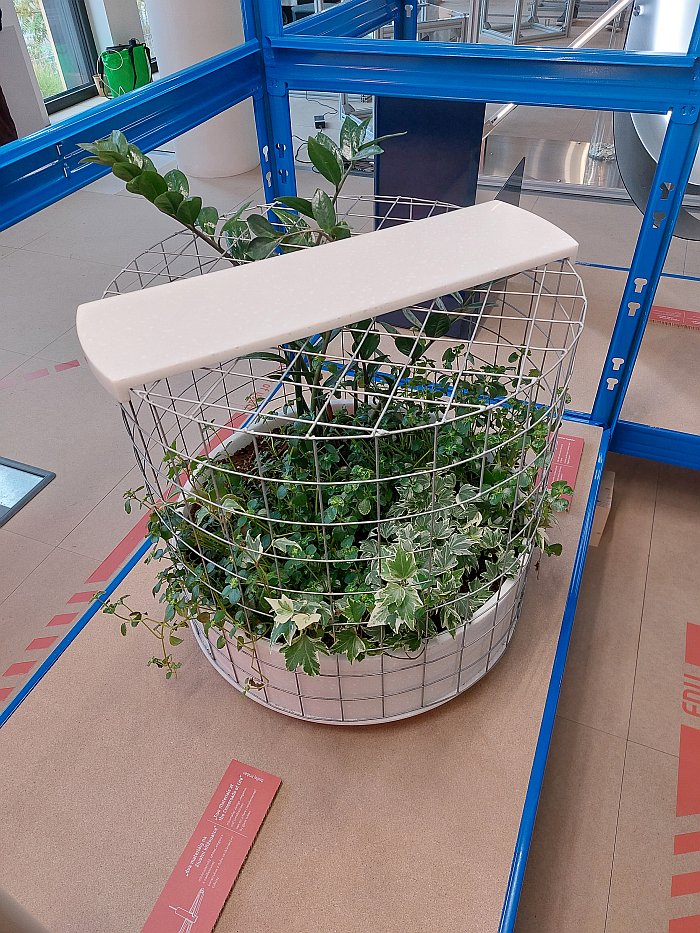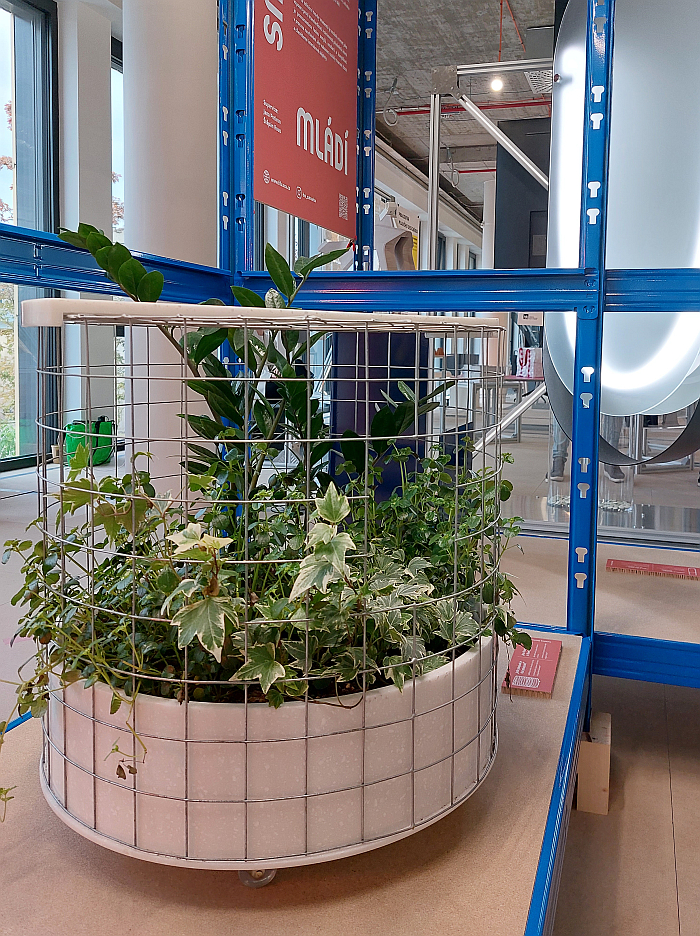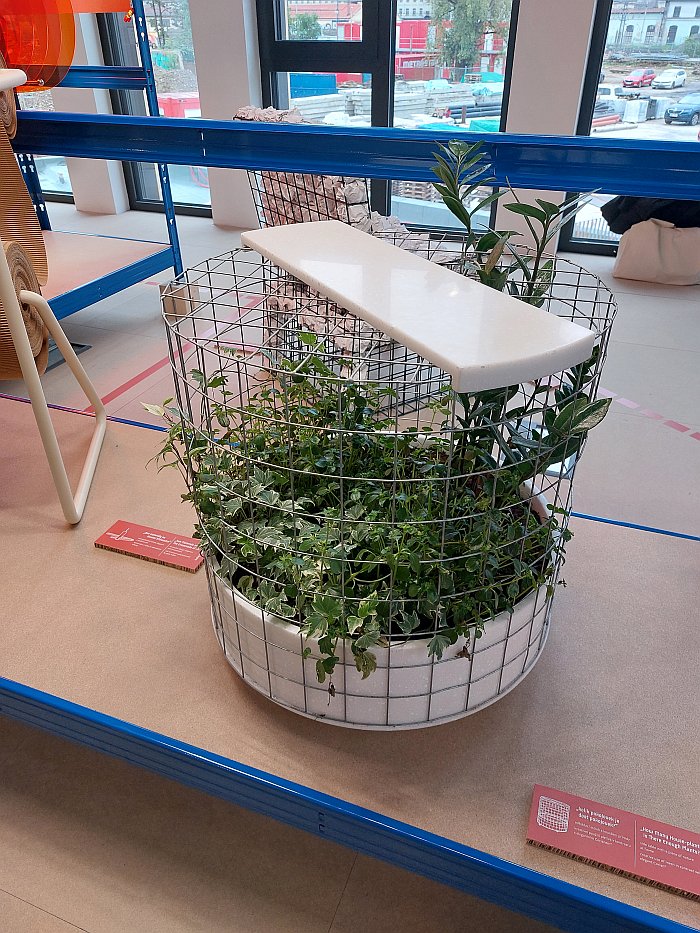
How many angels can dance on the head of a pin?
How many roads must a man walk down Before you call him a man?
How many Influencers does it take to change a lightbulb?
How many house plants are enough house plants?
Are there answers? Can there be answers? Must there be answers?
No, no and no, But that's not the point.
The point is the theorising, the posing of an abstract question, approaching an answer, never finding one, but analysing what you learned from the approach and then seeing where that which you have learned takes you.
For Sutnar Faculty of Design and Art, Plzeň, student Kateřina Husáková the question How many house plants are enough house plants? took her to an occasional table with space for those plants that simultaneously may or may not be enough, more than enough or nowhere near enough.
Realised, we believe, we could be wrong, in context of the semester course Smělost Mládí, Boldness of Youth, ✊ which challenged the students to reject the conventions of design, including a belief in the need, necessity, compulsion, to meet the expectations of a customer, to rebel 'against the standardisation and serialisation of objects', and to approach their chosen project with an open mind and a degree of Smělost Mládí, Kateřina's table initially caught our attention because with its wire mesh construction it looked like a plant prison.
Which is obviously wrong. Very wrong. Abhorrent.
So we cautiously slyed up to it to see if we could liberate the innocent incarcerated.... and as we approached and began to look for weak points in the prison's defences, we began to view it afresh, and realised it isn't a plant prison.
Terrariums are plant prisons, holding plants confined against their will and nature while forcing them to look at the freedom they will never enjoy. Behaviour thoroughly unbefitting for the human species.
Kateřina's object, an object definitely needing a useful name, How many house plants are enough house plants? can be the project name, is a good project name, but the object that arose from that project needs a name of its own... we'll propose Flowrenc, but not tell you why, if apologies to Kateřina for hijacking her project... but we digress... Kateřina's object isn't a plant prison, rather is space whose walls are implied more than present: not only can plants pass freely through the gaps in the wire that stands proxy for walls, but Kateřina has very kindly left some larger holes in the wire to allow plants to move through en mass, which is very humane of Kateřina. And also makes watering a lot easier. Functional and considerate. And not only can the plants pass through the walls, but they can pass through the ceiling, and twist around the wires on the top and sides, fill the spaces, expand upwards and outwards, meaning that over time Flowrenc will become the plants, the plants Flowrenc.
Thus very neatly, and very satisfyingly, echoing that way nature reclaims the built environment when humans move out of buildings and leave nature to its own devices; while through allowing plants to reclaim a space that would naturally be theirs if humans hadn't laid foundations and flooring and raised walls, hadn't obstructed the essential connections and relationships of nature for their own purposes, allowing that reclaiming while humans are still actively resident rather than waiting for their absence, helps elucidate that a co-habitation between plants and humans is possible. And thus represents a clear rejection of convention, with all the possibilities that always brings with it; rejects the belief that a building must be empty before plants can claim the space, thereby empowers Smělost Rostlin, the Boldness of Plants. ✊ And empowers us all to imagine alternative coexistences between humans and plants and urban spaces.
Not that Kateřina is advocating letting nature have compete control. Whereas the re-naturalisation of the built environment follows clear, local, patterns, with first a series of pioneer plants moving in before further species, often species dependent on both the pioneers and the fauna that flora encourages, complete nature's claim for the space; with Flowrenc you decide which plants you share your interior with. And how much they are allowed to grow, the degree to which they can claim the space. It's still very much nature under human control, that way we all like it, that way we're all comfortable with, but approaching a closer, equal, cooperation.
An equal cooperation that is as important in our interiors as it is in our exteriors, something that has been known and appreciated for a long time, and which, whether you believe in climate change or not, will become increasingly important in context of our ever warmer world and the benefits plants bring in regulating the local climate. If a cooperation we've long struggled to achieve. Not just on account of the human species long held arrogant belief in its natural superiority over plants, but also in terms of space. A Witold Lipiński, an early adopter and protagonist of bioclimatic aspects of architecture, for example, created a large window in the roof of his house in Wrocław to enable him to have a mini-forest on his top floor landing. Most of us don't have that option, must place plants where we can around our homes. And where a plant stands nothing else can. A reality that could cause one to question How many house plants are enough house plants? simply because you don't have unlimited space, and much as you'd like a Lipiński Forest, you needs must limit the number of plants, as a plant on a table, sideboard, bedroom cabinet, etc means nothing else can stand there and we all have and need other things. In our limited spaces.
But what if your bedroom cabinet was plants? What if your living room sideboard was plants? What if your occasional table was plants? What if your dining chair was plants? What if your office cabinet/sideboard/table/chair was plants?
Is the question how many house plants are enough house plants? still a question? Or does the focus and questioning shift? And if it does, how does that affect our relationship with the plant world and with the natural world?

Thus an object, a response to the question How many house plants are enough house plants? that through not only rejecting the popular conventions of plant/human relationships, but taking you beyond the popular appreciations of design, allows one to better approach a Lucius Burkhardt's contention that Design ist unsichtbar, design is invisible, that design is the immaterial intangible that surrounds us as much as it is physical objects, physical objects that impact on and influence the immaterial intangible, and which finds an echo in a Melchior Grau's "we are constantly trying to shape our environment and the environment shapes us in return". Or put another way, if the objects we design affect our behaviour and our thinking and thereby inform our perspective on the world around us and our relationships with the object world and the non-object world, objects that break with established conventions can stimulate alternative ways of behaving and thinking that can lead us to novel perspectives and novel relationships with the object world and the non-object world. Which, yes, is one of those responsibilities of designers, and architects, that a Victor Papanek highlights and which often aren't taken as seriously as they should be. And while anyone can develop those non-conventional objects, and non-conventional positions, the best placed are invariably those untroubled by years of conditioning, and by cynicism from the experience of life, the best placed are the young and for all those blessed with Smělost Mládí.
An object crafted from wire mesh and Corian in which there clearly exists a tension between the materials that is an important component of the expressiveness and agency of Flowrenc, but which if we're being honest, which we always try to be, didn't rock our boat. Will however, without question, rock the boats of others. Our appreciation of Flowrenc was elsewhere. Beyond the conventions of design
If an object that while it sounds faultless in theory, worked effortlessly in an empty office space in north-central Prague, the practice is going to be very different, and bring with it problems that can't be fully appreciated until you create a Flowrenc bedroom cabinet. Whereby light would appear a relatively obvious challenge. But not an insurmountable one, and a challenge that allows one to appreciate that while how many house plants are enough house plants? is an unanswerable theoretical question, which mix of house plants is the correct mix of house plants? is one much more anchored in the tangible. And one just as important for the meaningful cooperation between human and plants we all, and all our plants need. For the repositioning of plant/human relationships both sides need.
A re-positioning of plant/human relationships Kateřina has neatly approached via an object that is primarily about the plant not the container, which is not only an act we could all learn from, but which is important: occasional tables containing plants are a thing, but are generally about the tables with space found for plants, are objects for humans which imprison plants as much as terrariums do, and therefore perpetuate the belief that plants are subservient to humans. Are an alternative expression of that epiphany articulated by Adam Kvaček elsewhere at Designblock 2024 with his thesis The Paradox of Isoëtes. Future of Almost Lost Species that "the most common reason for growing plants is to meet human needs", is for human exploitation, a reality that must change. Flowrenc is very much a space for plants, an environment for plants, which Kateřina has persuaded the plants to consent to let humans use if they share their spaces with the plants. If, yes, the human retains the final word, but that reality will have had its day before all too long. We hope you're all ready.
Yet, and while we stand by all the above, and by the many other things limitations of space forced us to omit, we all shouldn't lose sight of the fact that Flowrenc, How many house plants are enough house plants?, is and was a student semester project and, as ever, is thus all about what Kateřina got from the project, not the object, engaging and appealing as it is. It's ultimately about Kateřina not Flowrenc. Which doesn't mean we don't hope Kateřina continues the project, the concept, we very much hope she does, that's however up to her alone; but the more interesting aspect is how the experience with the project, how the analysing what she learned from the project, influences and informs her further path.
More information on Kateřina Husáková can be found at ...we no know. We can find nothing online. Sorry!! Should that change, we will update.
Designblok Prague 2024 has now ended, more details on the event can be found at www.designblok.cz
